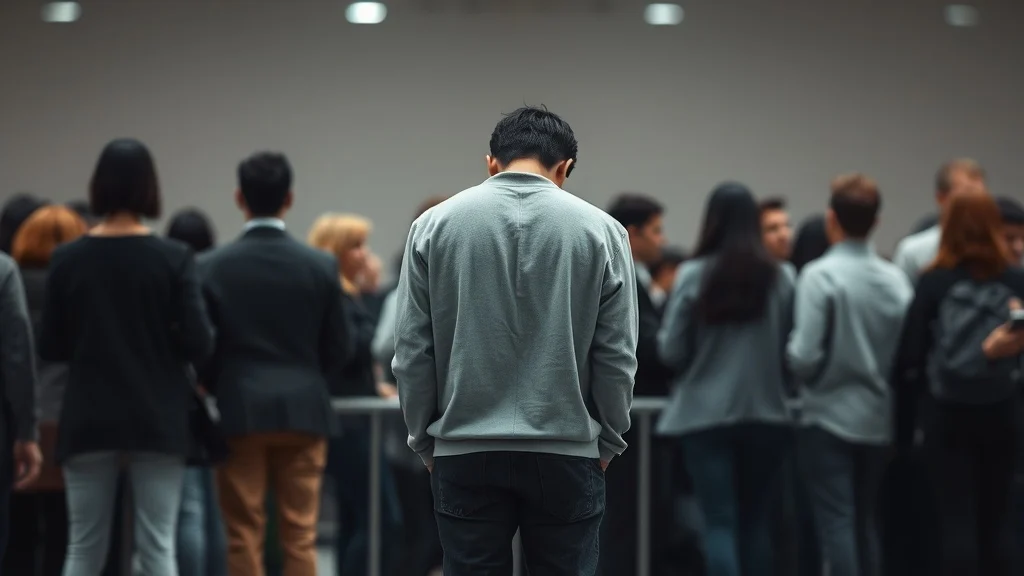8 Demographics of People Who May Dream of Adjacency
Want a Personalized Dream Interpretation?
Curious about how people like you interpret this dream symbol? Explore personalized interpretations tailored to your demographic. Get personalized insights for free!
Get Free Interpretation Now →Table of Contents
2. People with Low Self-Esteem
For those with low self-esteem, dreams of adjacency may reveal a deep-seated desire for acceptance and a fear of being isolated or alone. They may see themselves standing on the sidelines, watching others engage in social interactions with a longing to join but feeling too unworthy or inadequate to do so. These dreams can be an indication of a need to work on self-esteem, develop a greater sense of self-worth, and build stronger relationships.

3. People with Borderline Personality Disorder
Dream Symbol: Adjacency in Borderline Personality Disorder
For individuals with Borderline Personality Disorder (BPD), dreams involving adjacency often carry significant emotional weight. These dreams may reflect the intense emotional proximity yet perceived instability in their relationships.
Adjacency symbols in BPD dreams can manifest in various ways. They may involve scenarios where the dreamer is physically close to a person but feels an emotional disconnect. Alternatively, they may dream of being in a crowded space yet feeling isolated from those around them.
These dreams amplify the conflicting emotions that people with BPD experience in their interpersonal relationships. They crave intimacy and connection but simultaneously fear abandonment or rejection. The adjacency symbol becomes a poignant representation of this internal conflict.
By exploring the symbolism of adjacency in their dreams, individuals with BPD can gain insights into their relationship patterns and emotional vulnerabilities. These insights can empower them to navigate interpersonal challenges and foster healthier connections.
4. People with Dependent Personality Disorder
For individuals struggling with Dependent Personality Disorder (DPD), dreams of adjacency delve into their profound need for closeness and validation. They may yearn to be connected and supported, fearing abandonment and separation.
In these dreams, symbols of adjacency, such as being physically close or sharing a space with others, reflect their intense desire for attachment. They may find themselves clinging to loved ones or seeking constant reassurance from them.
The absence of adjacency in their dreams, on the other hand, can evoke feelings of isolation and despair. They may experience a sense of disconnection and emptiness, longing for the comfort and security that adjacency provides.
5. People who are Loneliness
Adjacency: A Beacon of Hope in the Sea of Loneliness
For those navigating the desolate waters of loneliness, dreams of adjacency offer a lifeline of solace and a glimmer of connection. These dreams often feature individuals or objects being directly beside the dreamer, providing a tangible sense of presence and support.
Loneliness can shroud individuals in a cloak of isolation, severing them from meaningful relationships. However, dreams of adjacency act as a gentle reminder that they are not alone. The mere presence of another being, even in the ethereal realm of dreams, can serve as a potent antidote to the gnawing ache of loneliness.
The objects in these dreams also hold symbolic significance. A chair beside the dreamer may represent a longing for companionship, while a book within easy reach may symbolize the comfort and solace found in literature. By placing these objects in close proximity to the dreamer, the dreamworld offers a subtle affirmation of their worthiness of connection.
Furthermore, adjacency in dreams can reflect a subconscious desire to break free from the confines of isolation. By placing another entity directly beside them, the dreamer may be symbolically expressing a yearning for intimacy and belonging. These dreams serve as a catalyst for introspection, encouraging the dreamer to identify their own needs and take steps towards fostering meaningful connections.
In the tapestry of loneliness, dreams of adjacency are threads of hope that weave a reassuring presence into the fabric of the dreamer's world. They remind individuals that even in their solitary moments, they are not truly alone and that the path to connection is always within their reach.
6. People who are Feeling Abandoned
Adjacency: A Symbol of Abandonment
For those grappling with the pangs of abandonment, dreams of adjacency can take on profound significance. Like an unwelcome neighbor, they can feel uncomfortably close yet utterly distant.
Adjacency in dreams mirrors the feeling of being on the fringes, existing in isolation despite being surrounded. It's the silent scream of loneliness that reverberates through the subconscious. Those who experience these dreams may feel invisible, like they're standing right next to life but can't fully engage.
Rooms next door or houses just across the way represent the unattainable connections that spark envy and yearning. They're a poignant reminder of the emptiness that abandonment creates. The dreamer gazes longingly at these symbols, aching to be included, but an invisible barrier holds them back.
Adjacency dreams are a haunting manifestation of the psychological isolation that abandonment fosters. They're a cry for connection, a desperate plea to bridge the gap between the self and others. Understanding their symbolism can empower individuals to address the root of their abandonment wounds and ultimately find the belonging they crave.
7. People who are Grieving
Dream Symbol: Adjacency for People Who Are Grieving
For those who are grieving, dreams of adjacency can hold profound significance.
These dreams often involve the presence of a loved one who has passed away, standing close by or even touching the dreamer. The proximity can bring a sense of comfort and connection, offering solace in the midst of loss.
In such dreams, adjacency may represent:
- The desire to be reunited with the deceased
- A longing for the presence and support they once provided
- An acknowledgement of the emotional bond that continues beyond physical separation
Through the symbolism of adjacency, these dreams provide a space for grief to be expressed and processed. They offer a glimmer of comfort and remind the dreamer that the love shared with their loved one remains even after their passing.
8. People who have Experienced Trauma
Dream Symbol: Adjacency for People Who Have Experienced Trauma
For those who have endured trauma, dreamscapes can become a mosaic of potent symbols. Among them, adjacency holds a profound significance.
Adjacency in dreams suggests a close proximity or association with an event, person, or emotion tied to the trauma. It may manifest as being physically close to a trigger or as having a sense of impending danger from something nearby.
Trauma survivors often experience dreams where they are adjacent to a perpetrator, a place where the trauma occurred, or a specific object that evokes memories of the event. These dreams can be disorienting and anxiety-provoking, as they bring the traumatic experience uncomfortably close.
Conversely, adjacency can also symbolize a longing for connection or a desire to confront the trauma. Dreams where individuals are adjacent to loved ones or safe spaces can provide solace and a sense of reassurance.
Moreover, adjacency in dreams may reflect a subconscious need to process the trauma by integrating it into the present. By being adjacent to the traumatic experience, the dreamer can explore their feelings and memories in a controlled environment.
Understanding the significance of adjacency in dreams can help trauma survivors navigate their dream worlds with greater awareness and agency. By paying attention to the proximity and association of objects or individuals in their dreams, they can gain valuable insights into their healing journey.
Back to interpretation of adjacency
